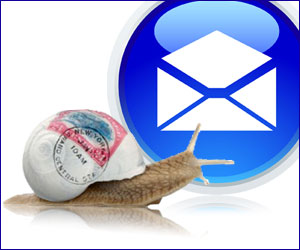How to Contact Potential Postdoctoral Advisors: Email vs. Snail Mail
by
 To say email changed the way we communicate is like saying Saturday morning group meeting is a bad idea – it’s obvious. For most of us, email (including messaging through Facebook and related sites) is the reason we write with the penmanship of a second-grader. (For those born after 1990, “writing” means holding a pen in your hand and physically creating the letters and words on a piece of paper that would then be mailed to the recipient. “Mail” means…) Since it’s inception, people have debated the appropriateness of sending an email versus a physical letter for a range of life’s occasions. In our professional lives we fear choosing the wrong vehicle will put an end to our candidacy before our merits are even considered. Accordingly, one of the most common questions we receive from the lab is whether we should contact potential postdoctoral advisors by email or a traditional letter.
To say email changed the way we communicate is like saying Saturday morning group meeting is a bad idea – it’s obvious. For most of us, email (including messaging through Facebook and related sites) is the reason we write with the penmanship of a second-grader. (For those born after 1990, “writing” means holding a pen in your hand and physically creating the letters and words on a piece of paper that would then be mailed to the recipient. “Mail” means…) Since it’s inception, people have debated the appropriateness of sending an email versus a physical letter for a range of life’s occasions. In our professional lives we fear choosing the wrong vehicle will put an end to our candidacy before our merits are even considered. Accordingly, one of the most common questions we receive from the lab is whether we should contact potential postdoctoral advisors by email or a traditional letter.
In large part, the only differences between the email and hardcopy debate is how they’re sent. In both cases, the materials prepared – a cover letter and CV – are the same. As a result, we’ll let these two battle it out based on the delivery mechanism as opposed to the materials being sent. So in the words of the great Michael Buffer, “Lllllllllet’s get ready to rumbllllllle!”
“In the red corner, weighing in at a svelt 0.0 pounds and just 41 years old, this fighter has a love of fiber optic cable and keyboards…Introducing Eeeeeeeeeeeeeemail!” When contacting a potential postdoctoral employer, it doesn’t get easier than email. Simply create a PDF version of a CV, write an email introduction and click send. Bam! Done. Of course, the ease of email is no secret, which means your message likely gets dumped into an inbox that’s cluttered not only with tens or hundreds of standard correspondences daily, but also with messages from other potential candidates.
“In the blue corner, weighing in at one ounce, this fighter was the reigning champion for thousands of years and has an obsessive fear of fire…Introducing Physicalllllll leeeeeeetterrrrrr!” Letters require more care and effort, but that’s precisely the point. Printing your materials on high-quality paper with a hand-written signature shows respect for the advisor and for the process, which may help you stand out from the crowd. Of course, that assumes the PI actually receives, opens, and reads the letter. It’s not uncommon that a PI may quickly scan a pile of mail for letters requiring immediate attention, while the remainders land in a pile somewhere in the office- usually in a can marked “recycle”…
So as the bell rings and the battle begins, who do you think wins? What’s the best way to contact potential postdoctoral advisors about a job?
.
[poll id=”97″]
.
Had success with a particular job search strategy?
.
.


Angelard Caroline
wrote on February 13, 2012 at 6:29 pm
Nice post! I definitely think that email have to be the way to contact people! especially with scientist people. For ecological purpose (the trees say thank you ;) ? because you will not be judge by your (bad) skill at "writing" nicely (scientist are not really poet or writers right?)? because you can present your letter/CV etc with all the programs that will be really useful if you do a postdoc (word, excel…)?
Maybe for all of that, and more.
Caroline
Yevgeniy
wrote on February 14, 2012 at 10:52 am
Anyone who has been inside a PI's office knows what their desk usually looks like: piles of manuscripts, papers, etc, etc… While a traditional letter has a nice personal touch to it, the chances are that it will get swallowed up by the pile of entropy in the PI's office and never surface. An email actually is retained by both you (in the outbox) and the person you are communicating with. You can easily follow the correspondence in the original message is included in the reply.
In this digital age, email has become the mode of communication. having said that, write your email as you would an actual letter, meaning proper formal English, double check your spelling and grammar and do not abbreviate. Imagine that you are talking to the person. When contacting a potential employer, include a cover letter addressing why you are interested in a potential project with them and what you have to offer. Include your actual CV as an attachment.
Once you have opened the line of communication, talked to the person, conducted an informational or phone interview, do send an actual Thank You card on paper. It has a nice touch, will be appreciated, and will demonstrate your "people" skills.
Yevgeniy.